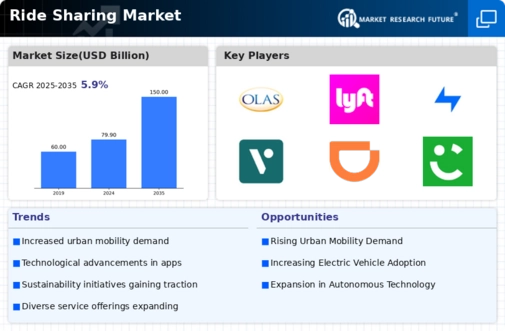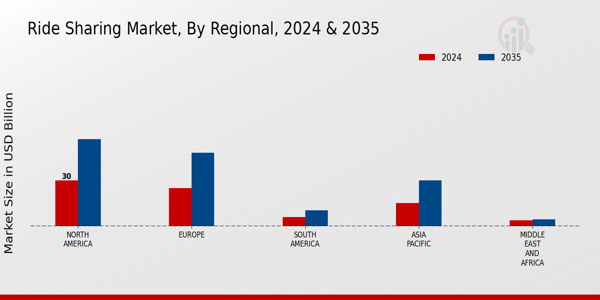Market Analysis
Ride Sharing Market (Global, 2024)
Introduction
In the midst of the city's mobility, the ride-sharing market has come to dominate, transforming the way people travel, both for work and for pleasure. The ubiquity of mobile devices, the increasing demand for cheap and convenient transportation solutions, the rise of ride-sharing services, the rise of the economy, the rise of the new generation of consumers, have led to a sharp rise in the use of these services, which have become an alternative to taxis and car ownership. The ride-sharing market is characterized by the presence of many different actors, from the great giants to the new entrepreneurs, each with its own value proposition and service offering. As urbanization continues to accelerate and as the need for sustainable mobility grows, the ride-sharing market will continue to evolve, influenced by regulatory changes, technological innovations and changing consumer preferences. The dynamics of this market are essential for any stakeholder wishing to seize the opportunities that arise and face the challenges inherent in this constantly changing environment.
PESTLE Analysis
- Political
- The ride-hailing industry in 2024 is highly regulated and controlled by the government. In San Francisco, for example, the ride-hailing companies must pay the city 50 cents per ride, which will generate about 10 million dollars a year for public transportation. In the European Union, the government is considering a stricter regulation of the gig economy, which could affect the cost of ride-hailing companies that rely on independent contractors, which would affect more than 1 million drivers in the European Union.
- Economic
- In 2024, the economy of ride-hailing is characterized by a fluctuating rate of inflation and fluctuating prices of oil and other energy resources. The average price of gasoline in the United States has risen to $ 4 per gallon, which directly affects the cost of operating a ride-hailing vehicle. In addition, the unemployment rate in the United States is a low 3.5%, which indicates a tight labor market, which may lead to increased wages for drivers and affect the cost structure of ride-hailing services. The economic conditions require strategic changes in the price of ride-hailing services to maintain profitability and compete effectively.
- Social
- In 2024, the attitude of the public to ride-sharing continues to evolve, with an ever-increasing emphasis on convenience and efficiency. In early 2024, a survey of city dwellers found that, compared with traditional taxis, ride-sharing services were preferred by 65% of the public, because of the perceived advantages of convenience and cost. In addition, 40% of the public favored the use of electric or hybrid vehicles for ride-sharing services, indicating a preference for more sustainable modes of transportation. This social trend is reflected in the ride-sharing companies’ investment in electric-vehicle technology, with a goal of increasing the percentage of EVs in their fleets by the end of 2024.
- Technological
- In 2024, the market for shared transport is rapidly changing. Artificial intelligence (AI) is now being used in the planning of routes, which has improved the service and shortened waiting times for customers to an average of five minutes. Moreover, the use of mobile payment systems has soared, and more than three-quarters of all shared-transport payments are now made with digital wallets, making life much easier for users. In addition, the companies are investing a billion dollars in the development of driverless vehicles and intend to launch pilot projects within two years.
- Legal
- The legal situation of ride-hailing is becoming increasingly complex in 2024, with different jurisdictions enacting new regulations. AB5 in California, for example, will classify “independent contractors” as employees, which will affect over 300,000 ride-hailing drivers in the state. This change in the law could increase the cost of operating a ride-hailing company because of the required benefits and protections for drivers. Ongoing litigation over data privacy and the safety of users will require ride-hailing companies to allocate about $ 50 million for legal compliance and defense in the next year.
- Environmental
- In 2024, the ride-hailing market is subject to the pressures of environmentalism, and companies are obliged to reduce their carbon footprint. The average carbon dioxide per trip is estimated at four kilograms, and many companies commit to being carbon neutral by the year 2030. In response, they invest in carbon-offset programs, with an estimated budget of $ 100 million for the environment. Local governments also work with the companies to promote ride sharing and reduce congestion, with the goal of reducing the city's emissions by 20 percent by 2025.
Porter's Five Forces
- Threat of New Entrants
- The ride-hailing market in 2024 will be subject to a moderate threat of new entrants. The threat of new entrants will be medium. Despite the significant initial capital outlay for technology and marketing, the growing demand for alternative means of transport will encourage new players to enter the market. The established companies will, however, benefit from economies of scale, brand awareness, and customer loyalty, which will act as a barrier to new entrants.
- Bargaining Power of Suppliers
- The bargaining power of the suppliers is relatively weak in the market for transport services. The main suppliers are drivers, who have many choices of platforms, which reduces their bargaining power. The technology and infrastructure needed to operate the platforms are also widely available, which again reduces suppliers’ bargaining power.
- Bargaining Power of Buyers
- The buyers of the transport service will have considerable negotiating power in 2024. There will be several possibilities for them to choose from, and they will be able to change their choice easily, based on price, convenience and quality. Competition will force the companies to develop and offer incentives and special offers in order to retain their customers, and thus strengthen the buyer’s bargaining power.
- Threat of Substitutes
- The threat of substitutes is high in the ride-hailing market. Public transport, the taxi industry and car ownership offer a wide variety of alternative ways of travelling. And new developments such as driverless cars could cause even greater disruption. Therefore, ride-hailing companies need to differentiate themselves in the market.
- Competitive Rivalry
- The competition in the ride-hailing market is fierce in 2024. A number of big companies are constantly trying to take market share from each other, which leads to aggressive price competition, special offers and new services. The numerous competitors, both established and newcomers, have created a highly competitive market in which innovation is essential to maintain a position.
SWOT Analysis
Strengths
- Strong brand recognition and customer loyalty among established players.
- Convenient and flexible transportation options for users.
- Integration of technology for improved user experience and safety features.
Weaknesses
- Regulatory challenges and legal issues in various markets.
- High operational costs and driver retention challenges.
- Dependence on smartphone technology, limiting access for some demographics.
Opportunities
- Expansion into underserved markets and regions.
- Partnerships with public transportation systems for integrated services.
- Adoption of electric vehicles to enhance sustainability and reduce costs.
Threats
- Intense competition from new entrants and traditional taxi services.
- Potential economic downturns affecting consumer spending on ride-sharing.
- Changing regulations and potential government interventions.
Summary
In 2024, the ride-hailing market will be characterized by brand loyalty and technological innovations that enhance the rider’s experience. However, it will face significant obstacles, such as regulatory restrictions and high operating costs. Opportunities for growth lie in expansion into new markets and strategic alliances. Threats include competition and macroeconomic volatility, which could affect the market’s profitability. The companies must navigate these shifting conditions carefully to maintain their market positions.












Leave a Comment